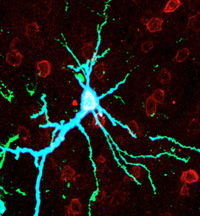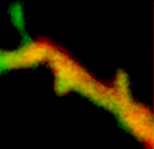Archived Content
The National Institute of Mental Health archives materials that are over 4 years old and no longer being updated. The content on this page is provided for historical reference purposes only and may not reflect current knowledge or information.
Enzyme Enhances, Erases Long-term Memories in Rats
Can Restore Even Old, Fading Memories, Say NIH-funded Scientists
• Press Release
Even long after it is formed, a memory in rats can be enhanced or erased by increasing or decreasing the activity of a brain enzyme, say researchers supported, in part, by the National Institutes of Health.
"Our study is the first to demonstrate that, in the context of a functioning brain in a behaving animal, a single molecule, PKMzeta, is both necessary and sufficient for maintaining long-term memory," explained Todd Sacktor, of the SUNY Downstate Medical Center, New York City, a grantee of the NIH's National Institute of Mental Health.
Sacktor, Yadin Dudai, Ph.D., of the Weizmann Institute of Science, Rehovot, Israel, and colleagues, report of their discovery March 4, 2011 in the journal Science.
Unlike other recently discovered approaches to memory enhancement, the PKMzeta mechanism appears to work any time. It is not dependent on exploiting time-limited windows when a memory becomes temporarily fragile and changeable — just after learning and upon retrieval — which may expire as a memory grows older, says Sacktor.
"This pivotal mechanism could become a target for treatments to help manage debilitating emotional memories in anxiety disorders and for enhancing faltering memories in disorders of aging," said NIMH Director Thomas R. Insel, M.D.
In their earlier studies, Sacktor's team showed that even weeks after rats learned to associate a nauseating sensation with saccharin and shunned the sweet taste, their sweet tooth returned within a couple of hours after rats received a chemical that blocked the enzyme PKMzeta in the brain's outer mantle, or neocortex, where long-term memories are stored.
In the new study, they paired genetic engineering with the same aversive learning model to both confirm the earlier studies and to demonstrate, by increasing PKMzeta, the opposite effect. They harnessed a virus to infect the neocortex with the PKMzeta gene, resulting in overexpression of the enzyme and memory enhancement. Conversely, introducing a mutant inactive form of the enzyme, that replaced the naturally occurring one, erased the memory — much as the chemical blocker did.
These effects applied generally to multiple memories stored in the targeted brain area — raising questions about how specific memories might be targeted in any future therapeutic application.
The researchers turned up a clue that may hold the beginning of an answer.
"One explanation of the memory enhancement is that PKMzeta might go to some synapses, or connections between brain cells, and not others," said Sacktor. "Overexpressed PKMzeta may be selectively captured by molecular tags that mark just those brain connections where it's needed — likely synapses that were holding the memory from the training."

A neuron in a rat brain's cortex over-expressing PKMzeta (blue).

Close-up of a neuronal extension, revealing that PKMzeta (yellow/red) appears to be selectively recruited only to certain brain connections, where it's likely needed to help support memories.
References
Shema R, Haramati S, Ron S, Hazvi S, Chen A, Sacktor TC, Dudai Y. Enhancement of consolidated long-term memory by overexpression of protein kinase Mzeta in the neocortex. 03/2/2011, Science.
How does PKM? maintain long-term memory? Sacktor TC . Nat Rev Neurosci. 2011 Jan;12(1):9-15. Epub 2010 Dec 1. Review. PMID:21119699
About the National Institute of Mental Health (NIMH): The mission of the NIMH is to transform the understanding and treatment of mental illnesses through basic and clinical research, paving the way for prevention, recovery and cure. For more information, visit the NIMH website.
About the National Institutes of Health (NIH): NIH, the nation's medical research agency, includes 27 Institutes and Centers and is a component of the U.S. Department of Health and Human Services. NIH is the primary federal agency conducting and supporting basic, clinical, and translational medical research, and is investigating the causes, treatments, and cures for both common and rare diseases. For more information about NIH and its programs, visit the NIH website .
NIH…Turning Discovery Into Health®
